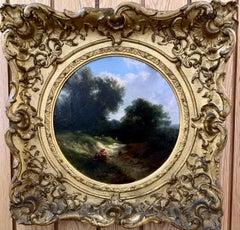George Cole On Sale
19th Century Realist Landscape Paintings
Oil
Recent Sales
1870s English School Landscape Paintings
Oil
1850s Victorian Landscape Paintings
Oil, Canvas
People Also Browsed
Late 19th Century Old Masters Landscape Paintings
Canvas, Oil
Late 19th Century Victorian Landscape Paintings
Oil
17th Century Old Masters Paintings
Oil
1980s English School Landscape Paintings
Canvas, Cotton Canvas, Oil
Mid-19th Century Realist Landscape Paintings
Oil
Mid-19th Century Victorian Landscape Paintings
Oil, Canvas
19th Century Victorian Landscape Paintings
Oil, Canvas
19th Century Landscape Paintings
Canvas, Oil
19th Century Old Masters Landscape Paintings
Oil
19th Century Victorian Landscape Paintings
Oil
1870s English School Landscape Paintings
Canvas, Oil
19th Century Landscape Paintings
Oil, Canvas
19th Century Victorian Landscape Paintings
Oil, Canvas
19th Century Victorian Landscape Paintings
Canvas, Oil
19th Century Victorian Landscape Paintings
Canvas, Oil
19th Century Victorian Landscape Paintings
Canvas, Oil
George Cole for sale on 1stDibs
George Cole was a portrait landscape and animal painter in oils. He was the father of George Vicat Cole. Cole was born in Portsmouth to James and Elizabeth Cole. His mother died when he was nine years old. According to the artist's grandson, Rex Vicat Cole, he was apprenticed to a ship's painter in the Royal Navy dockyards at Portsmouth. He taught himself to paint pictures, at first portraits and animals; he also painted posters for Wombwell's menagerie. In 1838, Cole's painting The Farm Yard was shown at the Society of British Artists. When he was 30, he changed his focus to landscapes and received instruction from John Wilson and started exhibiting in 1840. One anecdote has him painting the portrait of a Dutch merchant in Portsmouth. After the sitter refused to pay him, saying it was a bad likeness, Cole added wings and put the painting in a shop window with the title The Flying Dutchman. The man's friends recognized him and laughed; he paid for the painting and Cole painted out the wings. His career has been regarded as a good example of the Victorian self-made man. In 1831, he married Eliza Vicat, of an old French Huguenot family. In 1852, he moved to Fulham and in 1855 to Kensington, where he lived for the rest of his life. In the mid-1860s, he purchased Coombe Lodge, a small estate in Hampshire. In a series of richly colored and detailed landscapes on large canvases executed during the 1860s and 1870s, Cole created an idealized version of the Hampshire moorlands and agricultural landscape; examples include Fern Karting, Harting Coombe (1873, Russell-Cotes Art Gallery and Museum, Bournemouth). Cattle continued to play an important role in his compositions and he specialized in the depiction of river scenery with cows watering, including, for example, Windsor Castle. Although he exhibited 16 works at the Royal Academy, Cole's work formed a mainstay of the exhibitions of the Society of British Artists at Suffolk Street, where he exhibited 209 paintings from 1838 until he died in 1883. He was elected a member in 1850, became an auditor in 1856 and vice-president in 1867. He was also awarded a medal for a harvesting scene in 1864 by the Society for the Encouragement of the Fine Arts. George Cole died on 7 September 1883 at his home at 1 Kensington Crescent and was buried in Kensal Green Cemetery, London.
Finding the Right Landscape-paintings for You
It could be argued that cave walls were the canvases for the world’s first landscape paintings, which depict and elevate natural scenery through art, but there is a richer history to consider.
The Netherlands was home to landscapes as a major theme in painting as early as the 1500s, and ink-on-silk paintings in China featured mountains and large bodies of water as far back as the third century. Greeks created vast wall paintings that depicted landscapes and grandiose garden scenes, while in the late 15th century and early 16th century, landscapes were increasingly the subject of watercolor works by the likes of Leonardo da Vinci and Fra Bartolomeo.
The popularity of religious paintings eventually declined altogether, and by the early 19th century, painters of classical landscapes took to painting out-of-doors (plein-air painting). Paintings of natural scenery were increasingly realistic but romanticized too. Into the 20th century, landscapes remained a major theme for many artists, and while the term “landscape painting” may call to mind images of lush, grassy fields and open seascapes, the genre is characterized by more variety, colors and diverse styles than you may think. Painters working in the photorealist style of landscape painting, for example, seek to create works so lifelike that you may confuse their paint for camera pixels. But if you’re shopping for art to outfit an important room, the work needs to be something with a bit of gravitas (and the right frame is important, too).
Adding a landscape painting to your home can introduce peace and serenity within the confines of your own space. (Some may think of it as an aspirational window of sorts rather than a canvas.) Abstract landscape paintings by the likes of Korean painter Seungyoon Choi or Georgia-based artist Katherine Sandoz, on the other hand, bring pops of color and movement into a room. These landscapes refuse to serve as a background. Elsewhere, Adam Straus’s technology-inspired paintings highlight how our extreme involvement with our devices has removed us from the glory of the world around us. Influenced by modern life and steeped in social commentary, Straus’s landscape paintings make us see our surroundings anew.
Whether you’re seeking works by the world’s most notable names or those authored by underground legends, find a vast collection of landscape paintings on 1stDibs.

